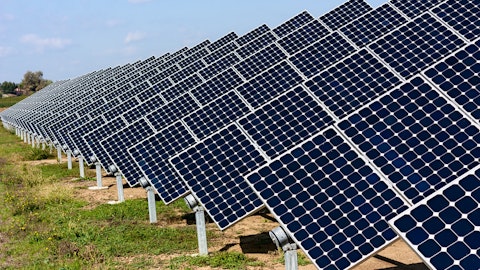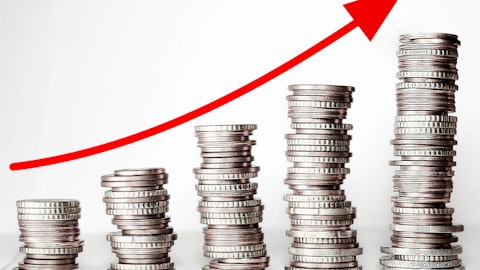Mark Jarvi: Okay. And then maybe one question for Francisco. Is there any option to resculpt some of the debt in Spain over the next year or two, here, just as you deal with the current parameters and the adjustments that come in 2026 to either enhance free cash flow in the short term or optimize the cash flow profile of those assets?
Francisco Martinez-Davis: We — as Santiago mentioned, I mean, we refinanced a couple of the projects. We continue to look actively, not only in Spain, Mark, but in — just the geographies where — that we have opportunities on those projects that have long tail. So to answer the question is yes, we continue to evaluate actively some of the refinancing opportunities, not only in Spain but in our whole portfolio.
Mark Jarvi: And those would not be in your guidance, those would be potentially beneficial or additive to the CAFD profile this year or next year?
Francisco Martinez-Davis: Mark, I mean they’re not in the guidance. I think they are more midterm opportunities. But as I said, this is something that we consider — that we keep evaluating on a constant basis, but more midterm opportunities, Mark.
Mark Jarvi: Got it. Okay. Thanks for the time today.
Santiago Seage: Thank you.
Operator: The next question comes from Angie Storozynski with Seaport. Please go ahead.
Angie Storozynski: Hi, good morning. So I was just wondering the — you mentioned, obviously, M&A opportunities, an ongoing strategic review. So is this strategic review basically a search for growth opportunity? I mean, it almost feels like we’re in this perpetual strategic review with no updates, no timeline, anything on what the target here is?
Santiago Seage: So on the strategic review, Angie, as you will understand, we cannot make any comments.
Angie Storozynski: Okay. And then on the Monterrey and the CAFD, so is it fair to assume that this contribution is basically like a debt paydown with the use of proceeds as — basically, that’s what it is for 2024 CAFD?
Francisco Martinez-Davis: Angie, I mean, it’s included in the guidance. What I mentioned before, with regards to use of proceeds, we have the deployment of the capital that we want to — that we have mentioned in the presentation, and part of the proceeds of Monterrey will be used to fund a portion of our development pipeline.
Angie Storozynski: Okay. And lastly, are you guys seeing any deterioration in the EBITDA, or more importantly, CAFD of existing assets like as they age? And I just — we obviously see it some existing wind power assets in the U.S. And I’m just wondering if you’re experiencing the same phenomenon across other assets and other jurisdictions?
Santiago Seage: So overall, my answer would be no. Obviously, each asset is different and you do need to work on your assets. You do need to spend some money to make sure that they are going to be — to continue generating what they need to generate. But overall, my answer would be no.
Angie Storozynski: Okay. Thank you.
Santiago Seage: Thank you, Angie.
Operator: The next question comes from William Grippin with UBS. Please go ahead.
William Grippin: Good morning. Thanks very much for the time. My first question, just clarifying here on the EBITDA guide. Does that include the gain on sale piece of the Monterrey sale that you’re contemplating? Looks like the CAFD guide includes the $30 million, I assume that’s the return on capital portion. Just wondering where the gain shows up if anywhere in the guidance?
Francisco Martinez-Davis: It’s in the CAFD, as we mentioned before. And is that — there is a onetime gain that’s small on sale of the Monterrey asset, William, but it’s not material.
William Grippin: Is that reflected in — so how do we bridge the gap then between the $30 million you’re showing for the CAFD walk versus the $45 million to $52 million proceeds that you’re anticipating? I mean, is that $15-plus million begin to show up? Is that what’s adding to the EBITDA guidance? Or is this something less than that?
Francisco Martinez-Davis: William, let’s do something. It’s — let’s walk through that to fine-tune the numbers. As said, the transaction hasn’t closed. Let us circle back to you with that question.
William Grippin: All right. Fair enough. And just wanted to — coming back to some of your comments on M&A. What types of assets are you seeing most attractive opportunities for you here potentially? And where are they in their life cycle? Are these maybe assets that are a bit more seasoned or were things that have more recently been developed and commissioned?
Santiago Seage: So in terms of potential acquisitions, we spent time looking at assets in operation, mature with a lower risk profile. Obviously, the challenge is to find such opportunities at the right return. So typically, when we do acquisitions, it will be assets where we have some sort of competitive advantage, either because it’s close to assets we own already or because there are some synergies somewhere that allows us to make an additional return. And those would be the opportunities we will be closing. Additionally, we spent a bit of time, sometimes looking at assets in earlier stages where we can still add value, improve them. But historically, most of our investments have been assets in operation, generating the cash, low risk where we can add some value and get a higher return than anybody else. That’s what we need to do in order to make sure that those investments are accretive, obviously.
William Grippin: All right. Thanks very much for the time. I’ll pass it one.
Santiago Seage: Thank you.
Operator: Our next question comes from Rupert Merer with National Bank of Canada. Rupert, please go ahead.
Rupert Merer: Hi, good morning. Just to follow up on that last question on M&A. So is it fair to assume, you wouldn’t look at M&A in any new jurisdictions at this point, but just focus on where you have an existing footprint?
Santiago Seage: No. I wouldn’t say that, but there would need to be clear synergy value creation or a situation where we can achieve the return we need.




